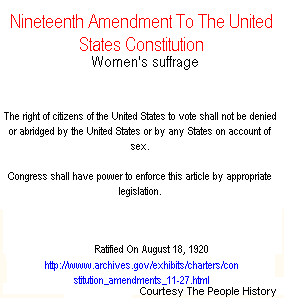
Remember all those amendments to clarify the rights of people to vote? Apparently they forgot women in that mix. You know, since being a citizen and race being no bar to vote weren't enough. You'd think by this time someone would have figured out that if you don't EXPLICITLY say everything in an amendment, it doesn't cover everything. Weird, I know.
Video:
Iron Jawed Angels, eh? Never caught the movie, but this small rendition does show some of the things women had to go through to gain the right to vote. I guess they kind of had to be Iron Jawed.
Article:
History of 19th amendment
Overview of the women's movement to gain the right to vote in the United States from the mid-1800's to the early 1900's.
The 19th Amendment - Voting Equality For Women
What Was the 19th Amendment?
The 19th Amendment is a simply worded Article to the U.S. Constitution. As Article XIX it reads that voting rights of citizens of the United States shall not be denied on the basis of sex. The House of Representatives passed the 19th amendment in 1919 by a vote of 304 to 90. The Senate passed the amendment 56 to 25. The required thirty-six states finally ratified the article on August 18, 1920.Women had lobbied for their voting rights, or suffrage, for many years before this amendment came into being. Many historians place the beginning of the women's suffrage movement in July of 1848 in Seneca Falls, New York. It was there that Elizabeth Cady Stanton and Lucretia Mott organized the first convention regarding women's rights and the woman's right to vote. Many of the backers of suffrage movement were also abolitionist sympathizers. Many abolitionists promoted universal voting rights for blacks and whites. Abolitionists saw success as the 15th amendment of 1870 granted voting rights to black men was passed. It was a natural connection then, for anti-slavery persons to be involved in women's voting rights. Frederick Douglass, the great black abolitionist leader, attended the Seneca Falls convention. In an editorial in the North Star, Douglass wrote that he saw absolutely "no reason" to withhold the right to vote from women. Later, in 1877, Douglass also signed a petition to the U.S. Congress in regards to women's suffrage.
In 1869, well-known suffragists, Susan B. Anthony, Elizabeth Cady Stanton formed the National Woman Suffrage Association, or NWSA. In 1871, a petition signed by Susan B. Anthony, Elizabeth Cody and many other suffragists was sent to Congress asking that voting rights be given to women. The petition also asked that women be given the right to speak in Congress. It was obviously not granted at that time.
Following the Civil War, the suffragist movement was divided due to differences in ideology. Two separate organizations pursued voting rights for women. The NWSA was more aggressive in their attempts to win suffrage. Lucy Stone, Julia Ward Howe and ThomasWentworth Higginson did not agree with this more militant attitude. They formed a separate organization, the American Woman Suffrage Association, or AWSA in November 1869. These two groups pursued the woman's right to vote separately until 1890, when the two groups joined together and formed the NAWSA or National American Woman Suffrage Association. Elizabeth Stanton was the new organization's president. In 1919, this group later changed and became the still existing League of Women Voters.
Opposition to women's suffrage came from women, as well. Some women believed the political process was demeaning to their roles as wives and mothers. In the state of New York, for example, there was a Women Voters Anti-Suffrage Party that circulated a petition against women's suffrage in 1918.
At the same time, pro-suffragists were pushing that President Woodrow Wilson support the proposed amendment. The suffragists held vigils outside the White House. They carried banners attacking Woodrow Wilson and compared him to the leader of World War I Germany, Kaiser Wilhem II. These vitriolic demonstrations often ended in arrests and public violence. Some women would suffer arrest in promoting the suffragist cause. In 1872, Susan B. Anthony registered and voted in Rochester, New York. She was arrested, convicted and fined $100. Susan B. Anthony never paid the fine and in 1874 petitioned the United States Congress to release from the fine. She argued that the conviction was unjust.
Several states promoted suffrage for women. New York state passed a women's voting law in 1917. In 1918, President Woodrow Wilson began to support the need for a constitutional amendment to which he had previously been opposed. When ratification by the states was begun on June 4, 1919 it only took six days for Illinois, Michigan and Wisconsin to all ratify the amendment. Kansas, New York and Ohio followed on June 16, 1919. The last required 36th state to ratify was Tennessee, who barely ratified the amendment on August 18, 1920. The Tennessee vote to ratify hinged on one vote, the vote of a 24-year-old state legislator by the name of Harry Burn. He had originally voted against ratification. He changed his vote after his mother urged him to do so. Even after his vote, anti-suffrage rallies were held and anti-suffrage state legislators left the state so that a legislative quorum could not achieved. The Tennessee ratification was achieved and the required 36 states met the constitutional requirement.
The remaining twelve states of the Union took over sixty years to add their ratifications of the 19th amendment. Ten of these states originally had rejected ratifying the amendment. Mississippi was the last state of the 48 states to ratify the amendment when it did so on March 22, 1984.
Written by Robert Wheadon - © 2002 Pagewise
Reaction:
I like history articles, as many people don't actually know the histories of how our amendments came to be or the forces that were behind them. It's always important for our younger generations to not forget about the past, as it tends to repeat itself.
No comments:
Post a Comment